NEXT-GENERATION ULTRA-HIGH-SPEED MICROWAVE
Photonic integrATed circuiTs using advancEd hybRid iNtegration
Demonstrators
PATTERN will develop 6 demonstrators for highly relevant industrial application areas.
The demonstrators serve multiple purposes, in particular to show
- how the new advanced building blocks (insulators, AOMs and microwave photonic components) can be monolithically integrated into complex PICs;
- how PATTERN goes beyond the state of the art in these applications;
- the superior performance of the new hybrid PICs.
The demonstrators also allow to obtain feedback from end users already in the early development stages.
Learn more about PATTERN’s demonstrators
Demonstrator 1: Low phase noise optical RF oscillators up to 300 GHz (partners MWP & THALES)
PATTERN investigates two complementary approaches: the first (a) is based on opto‐electronic oscillators (OEO), and the second (b) on optical combs.
a) Heterogeneous combination of active and passive photonic components with high-speed electronics on a single integrated circuit
Opto-electronic oscillators (OEOs) are a promising alternative to classical quartz oscillators for high-purity microwave generation beyond the GHz range. THALES is currently involved in the development of such high-performance OEOs to set new RF standards for telecommunication payloads and RADAR systems. However, OEOs suffer from low integration as they remain an assembly of components (e.g. laser, modulator, photodiodes, RF amplifiers).
PATTERN will enable the heterogeneous combination of active and passive photonic components with high-speed electronics on a single integrated circuit. In addition, the LNOI-based modulators will have ultra-low driving voltages. These two key features will dramatically improve the SWaP-C performance of OEOs and make them an unrivalled technology for RF generation above 10 GHz.
Thanks to the technological know-how of the partners CSEM, HHI, IMEC, THALES and PHIX, PATTERN will provide a state-of-the art 30 GHz OEO fitting in a 0.2 L volume by the end of the project.
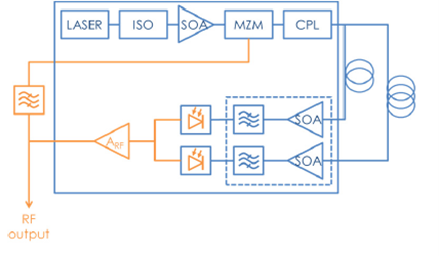
Architecture for OEO double optical delay loops to reduce phase noise (THALES)
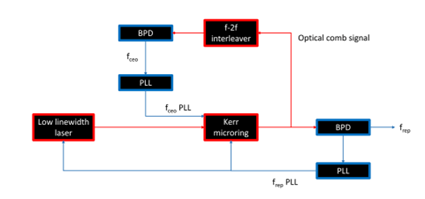
Low phase noise optical RF oscillators up to 300 GHz (MWP)
b) Low phase noise optical RF oscillators based on optical combs
A second approach for a demonstrator with low phase noise optical RF oscillators up to 300 GHz is being pursued by PATTERN partner Microwave-Photonics GmbH (MWP). It is based on optical combs. The optical generation of low phase noise reference signals using optical combs has been a research objective for some years and was awarded the Nobel Prize in Physics in 2005.
PATTERN aims to develop – for the first time to our knowledge – PICs for generating high‐frequency signals (between 16 GHz up to 300 GHz) with low phase noise. The PIC will include a low‐linewidth InP‐LNOI hybrid laser (<1kHz) and a passive nonlinear ultralow‐loss engineered‐dispersion LNOI optical ring resonator for comb generation, a fast integrated AOM to tune‐in into the nonlinear resonance and the f2f interleaver.
The ring resonator will be designed by MWP and fabricated by CSEM. For optical to electric conversion, photodiodes from HHI (<110GHz) and MWP (110 GHz up to 300 GHz) will be used. For RF integration, various techniques developed within PATTERN will be considered. For optical integration, edge‐coupling is foreseen. Thales and MWP will collaborate on methodology and share instruments to measure the phase noise of their respective oscillators.
Demonstrator 2: Continuous-Variable Quantum Key Distribution Receiver PIC (partner MWP)
Quantum Key Distribution (QKD) is a revolutionary security technology that exploits quantum mechanics to achieve secure key exchange and is considered one of the most promising quantum technologies for short to mid‐term commercial exploitation.
In PATTERN, the partner Microwave Photonics GmbH (MWP) will develop an integrated optical receiver for continuous‐variable quantum key distribution (CV‐QKD) that would not need specific optical functions like single‐photon detectors, which prevent photonic integration. The aim is
to integrate a high‐contrast fast optical switch for receiver calibration and connect it to a balanced photodiode with integrated 2×2 MMI. The optical local oscillator required for the CV‐QKD will exploit the low‐linewidth lasers (<1kHz) that can be achieved by means of LNOI PIC technology.
As an additional security feature, MWP will develop an RF circuit that allows measuring the DC‐photocurrents of the individual photodiodes to detect an attack. To be able to detect the quantum key at an extremely low signal power below the noise floor, an integrated broadband RF interposer for impedance matching between the balanced photodetector chip and a TIA has to be developed. The optical CV‐QKR receiver targets to support broadband detection up to 5 GHz.
MWP will qualify the receiver sensitivity and validate the CV‐QKD optical receiver in a fibre-optic network.
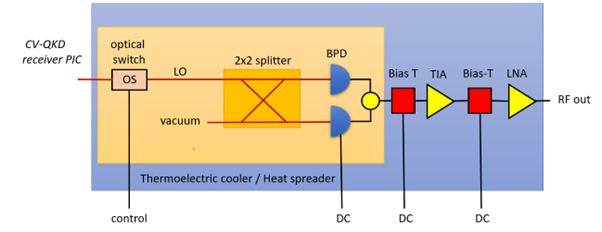
CV-QKD receiver PIC (MWP)
Demonstrator 3: THz Frequency System for Wireless Over-Fibre Links (partners UCL and MWP)
Growing demand for higher bandwidth wireless capability, met by 5G/6G systems, will require operating within the underutilized THz frequency spectrum above 100 GHz, for which high-frequency photonic devices are key enablers.
Developed in PATTERN, advanced LNOI modulator packages supporting high bandwidths and low Vπ will allow high carrier frequency wireless and over-fibre connectivity with significantly improved power efficiency and drastically reduced footprints.
Experimental demonstrations of both a wireless THz bridge and mm-wave over-fibre will be assessed to showcase the link performance improvements enabled by PATTERN.

Possible uses of integrated LNOI modulators for THz wireless-over-fibre applications (UCL)
Demonstrator 4: Free-Space Communication (partner THALES)
In free-space communication, information is transmitted by modulated light that propagates in air or vacuum, as opposed to glass in fibre-optic communications. Free-space communication technology is currently considered the most promising approach to meet the continuously growing demand for high-data-rate communication for links between satellites in low or geostationary orbits. However, atmospheric turbulences impair the link quality as the beam needs to be focused on the reception side due to the small size of high-bandwidth detectors.
PATTERN will demonstrate an integrated binary tree architecture (BTA) based on coherent recombining. When combined with a multi-plane light converter (MPLC), this novel BTA compensates for deleterious turbulences and focuses the beam efficiently on the detector. Thanks to the characteristics of LNOI, PATTERN’s BTA will have considerably lower coupling and propagation losses and will be much faster than the SOI-PIC-based BTAs Thales previously manufactured. PATTERN’s free-space demonstrator will feature higher recombined total power, more input channels and less voltage commands. It will be tested with a turbulence simulator internally developed by Thales.

Receiver and wavefront emulator test bed (THALES)
Demonstrator 5: Optical Phase-Locked Loop (partners UCL and THALES)
An optical phase-locked loop (OPLL) is a feedback system that coherently locks two otherwise uncorrelated lasers, where the feedback loop consists of an error signal propagating through both photonic and electronic circuitry. The OPLL feedback mechanism is limited by the need for a large bandwidth loop and very short propagation delay to enable fast phase tuning within broad bandwidths.
PATTERN will apply a co-designed integrated electronic and photonic circuit, implementing micro-transfer printing to achieve very short path delays. Furthermore, fast-tunable, narrow linewidth lasers will be developed on the LNOI platform supporting reduced noise integration within the loop, improving loop residual phase noise.
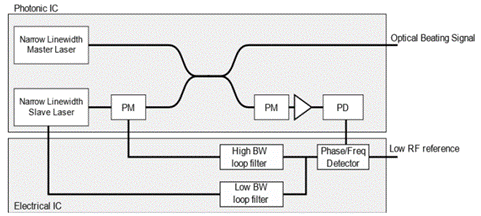
Optical phase-locked loop (OPLL) (UCL)
Demonstrator 6: Optical Engine for Gyroscope (partner THALES)
Passive resonant optical gyroscopes are an alternative to standard ring laser gyroscopes or interferometric fibre-optical gyroscopes. THALES is currently developing two approaches based on a cavity made of fibre (either standard or hollow-core) or a cavity made of mirrors in a free-space implementation. Thales has patented a solution to solve the backscattering issue that affects passive resonant optical gyroscopes and impedes precise low-rotation-rate measurements.
The technology relies on probing a gyroscope cavity on different resonant frequencies. This can be achieved by splitting a single laser beam into multiple beams. The optical frequency of each beam is then shifted by an acousto-optic modulator (AOM). Current AOMs are not compact and not energy-efficient enough; several RF frequency are required to drive them. In PATTERN, two 100% PIC-compatible alternatives will be tested:
- Integration of acousto-optic modulators on PIC, possible thanks to the piezoelectric properties of lithium niobate
- Phase-locking of several lasers, possible on a PIC through heterogeneous integration of fast (5-10 GHz) photodiodes and gain sections (for the hybrid lasers)
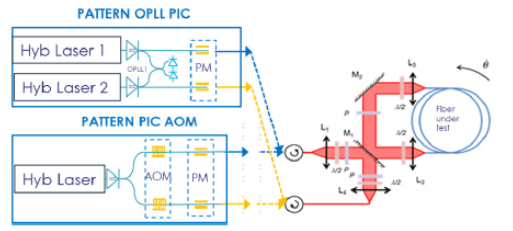
schematic of passive resonant optical gyroscope based on a hollow-core fibre and two probing setups (THALES)
